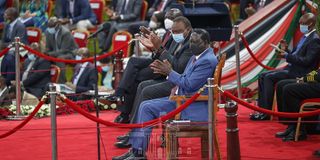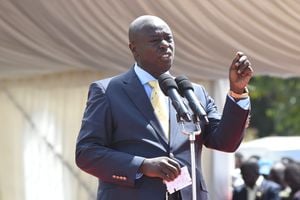National consensus needed on changes to Constitution

Deputy President William Ruto, President Uhuru Kenyatta, ODM leader Raila Odinga and other top officials at Bomas of Kenya in Nairobi for the launch of the Building Bridges Initiative (BBI) report on October 26, 2020.
During discussions that led to the March 2018 détente between President Uhuru Kenyatta and former Prime Minister Raila Odinga, they identified ethnic antagonism and competition, divisive elections and lack of inclusivity as causes of endemic national upheaval.
In May 2018, the President established the Building Bridges Initiative (BBI) task force, which was subsequently re-designated as a steering committee in October 2019. Both the task force and the steering committee were charged with evaluating the country’s political and socio-economic cyclic challenges and subsequently recommending necessary reform proposals.
The second BBI report, which contains the proposed Constitution of Kenya (Amendment Bill, 2020), was unveiled by the steering committee in October 2020. This Bill seeks to amend or repeal and create new provisions in relation to 67 of the 264 articles of the current Constitution and schedules.
I intend to review some salient features of the proposed constitutional changes.
The two-decade journey to the 2010 Constitution produced five drafts – in 2002, 2004, 2005, 2009 and 2010. The last draft birthed the 2010 Constitution.
Prime minister
The emphasis of the 2020 amendment proposals is the restructuring of the Executive by creating the positions of prime minister and two deputy prime ministers. Coupled with offices of the president and deputy president, the five top executive positions are expected to mitigate the winner-takes-all conundrum.
Consequent national stability would flow from reduced elite scramble for power. Assuming the executive pentagon was sourced from the most populous ethnic communities; Kikuyu, Luhya, Kalenjin, Luo and Kamba, who constitute about 67 per cent of the country’s population, genuine inclusion would still demand that the other 36 or so communities be similarly accommodated in the national executive leadership at all levels. Article 130(2) of the 2010 Constitution provides: “The composition of the national executive shall reflect the regional and ethnic diversity of the people of Kenya.”
The envisaged prime minister is the leader of government business in the National Assembly, who oversees legislative agenda, a role currently played by the majority leader. He/she is to supervise and coordinate execution of functions of ministries and government departments and chair Cabinet sub-committees.
Majority party
The prime minister is to be nominated by the president as the person who is leader of the majority party or coalition in the National Assembly, with its approval. The president can dismiss the prime minister, but the grounds for dismissal are not outlined.
The two deputy prime ministers appointed by the president must concurrently be Cabinet ministers. The president can dismiss them. Again, the grounds thereof are not provided. If the president relieves the deputy prime minister of his/her Cabinet portfolio, they automatically cease to hold such office.
Clearly, in the proposed expanded Executive, the president is a dominant constitutional persona.
In the Ghai draft, 2002, the prime minister was the leader of Cabinet and he/she presided over its meetings. He/she nominated the deputy prime ministers and the other ministers, who, upon vetting, were appointed by the president. In the Bomas draft, 2004, and the harmonised draft, 2009, the prime minister is head of government and presides over Cabinet.
The new five-headed executive could turn shaky if the president and his/her political party or coalition fail to muster a parliamentary majority. There would then exist two centres of power. Also, if the president is abandoned by a coalition partner, their government could collapse.
The proposed amendment creates the office of the leader of opposition, ranked third in the National Assembly after the speaker and prime minister.
Presidential nomination
Under the new 2020 proposals, Cabinet ministers, assistant ministers and principal secretaries will no longer be vetted by the National Assembly. This correspondingly enhances the power of presidential nomination and appointment.
Since 1969, electoral injustice has been touted as the engine of political instability during the election season. The BBI proposes that the electoral commission will consist of seven members, four of whom shall be representatives of parliamentary political parties. The dominant political parties would significantly influence the appointment of the commission, thus eroding its independence.
Although the proposals have strived to solve the two-thirds gender principle for the 290 contested National Assembly seats, this is yet to be accomplished. Parties may nominate under Article 81(b) female candidates in constituencies where they have scanty support. Such candidates would fail, thus negating the gender principle. Also, the use of the zebra formula for the 70 seats can only achieve 35 seats of either gender.
Judiciary ombudsman
The proposed judiciary ombudsman appointed by the president to conduct enquiries against judicial officers offends the separation of powers and independence of the Judiciary. Judges, for example, may be removed through a constitutional tribunal. The Judiciary has its own internal mechanisms for complaints processing. So why create a new special ombudsman?
Under the BBI proposals, the Office of the Director of Public Prosecutions (DPP) is converted to an independent office whose removal is to be undertaken through the National Assembly instead of a special tribunal. As a consequence, the DPP may feel compelled to look over his/her shoulder when prosecuting legislators and the Executive.
The constitutional proposals have converted the National Police Service Commission into a Kenya Police Council headed by the Cabinet minister in charge of security. Since 2007/2008, the independence of the police and its reformation have been on the national radar.
Although corruption is a debilitating national malaise, the 2020 proposals offer as remedy effective and expeditious investigation, prosecution and trial of integrity-related cases. The entrenchment of an Ethics and Anti-Corruption Commission within the Constitution with prosecutorial powers would more effectively combat corruption.
The BBI proposals haven’t elevated the Senate to be the upper house whose primary role is to defend devolution. It is instructive that Article 105 of the Ghai draft identified the National Council (Senate) as “an upper house”.
The land question
BBI proposals failed to address the land question, including its historical injustice dimension. Public land and community land need to be secured. Implementation of the Ndung’u report would partially address this concern.
Some BBI constitutional proposals also have merits. Examples of these are: enhancing equitable share to devolved units from 15 to 35 per cent; establishment of a youth commission (a special youth fund can be established under the Constitution); creation of ward development fund; making provision for allocation of public revenue and elective positions on the basis of population but with due recognition of minorities; provision of 50 per cent of a county’s budget in advance upon failure of Parliament to pass division of revenue law; and so on.
A window needs to be opened for a national conversation on the state of the nation and the Constitution of Kenya (Amendment) Bill 2020. Constitution-making is usually accomplished through national consensus building.





